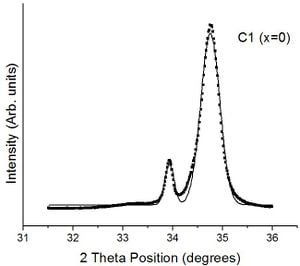No edit summary |
No edit summary |
||
| Line 18: | Line 18: | ||
*Batch scans can be run to save time and work more efficiently if a number of scans need to be completed. | *Batch scans can be run to save time and work more efficiently if a number of scans need to be completed. | ||
*The software on the computer has some analysis features that allow for filtering and smoothing of curves, however these features were not used in the testing by Dr.Pearce's group. | *The software on the computer has some analysis features that allow for filtering and smoothing of curves, however these features were not used in the testing by Dr.Pearce's group. | ||
*Manuals on the X'Pert XRD machine can be found in the XRD room in Stirling and provide a helpful guide to the various capacities and abilities of the machine. | |||
*Many excellent websites and books can be found that detail the various applications and techniques used in XRD analysis. | |||
| Line 28: | Line 30: | ||
[[Category:Queens Applied Sustainability Group Lab Protocols]] | [[Category:Queens Applied Sustainability Group Lab Protocols]] | ||
[[Category:Materials processing]] | [[Category:Materials processing]] | ||
Revision as of 16:10, 21 August 2009
Introduction

W (XRD) is a material characterization technique that can be useful for analyzing the lattice structure of a material. The basic principle behind XRD is Bragg’s Law of diffraction. By emitting x-rays at a sample and measuring the reflections and angles at which the reflections occur at, many different types of information can be obtained. Lattice parameters, texture orientations, and crystal structures can all be directly obtained from XRD. Often XRD is used for chemical analysis and a database exists of XRD scans of many types of materials for comparison. The database can be used to check a material’s XRD ‘fingerprint’ pattern to determine the composition. There are several different types of scans and subsections of XRD such as power diffraction, theta-2theta scans, reciprocal space mapping, and x-ray rocking curve scans.
At Queen’s University, several XRD machines exist around campus, including two in the basement of Jackson Hall (including a rotating anode XRD) and a Phillip’s X’pert XRD machine on the 5th floor of Stirling Hall. This rest of this article will pertain specifically to the XRD machine in Stirling Hall.
General Use Protocol and Tips
- XRD machines have built-in safety switches and features that are in place to protect users from accidental exposure to x-ray radiation. Under no circumstances should these safety switches be disabled.
- The XRD machine requires training by a member of the physics group that is qualified to instruct others. Familiarity with the machine and software is required.
- If the x-ray tube has been turned off, the tube must be first bred to warm up the machine before being used for testing.
- Sample alignment needs to be conducted before running any scans. Alignment is best done using the narrowest beam optics.
- The x-ray optics must be calibrated and optimized to give the best signal to noise ratio. These optics include the primary optics, attentuators, beam masks, receiving optics, and any other filters. For example, in the InGaN tests recently completed by Dr.Pearce's group, the following optics were used for testing: 2 Degree Divergent Slit, #10 Beam Mask, 0.5mm Receivin Optics.
- The x-ray tube voltage and current can be varied to change the intensity of the x-ray beam. For sample alignment, 15kV and 5 mA was used, while for testing, 50kV and 30mA was used.
- Ensure that a beam attenuator is in place if the beam is on and directed at the detector, as the detector can be saturated if the intensity is too high.
- Batch scans can be run to save time and work more efficiently if a number of scans need to be completed.
- The software on the computer has some analysis features that allow for filtering and smoothing of curves, however these features were not used in the testing by Dr.Pearce's group.
- Manuals on the X'Pert XRD machine can be found in the XRD room in Stirling and provide a helpful guide to the various capacities and abilities of the machine.
- Many excellent websites and books can be found that detail the various applications and techniques used in XRD analysis.
Booking information
For all booking information, rates and schedules, please see the Materials Physics cleanroom page.